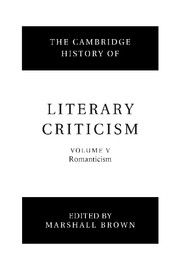Book contents
- Frontmatter
- Introduction
- 1 Classical standards in the period
- 2 Innovation and modernity
- 3 The French Revolution
- 4 Transcendental philosophy and Romantic criticism
- 5 Nature
- 6 Scientific models
- 7 Religion and literature
- 8 Language theory and the art of understanding
- 9 The transformation of rhetoric
- 10 Romantic irony
- 11 Theories of genre
- 12 Theory of the novel
- 13 The impact of Shakespeare
- 14 The vocation of criticism and the crisis of the republic of letters
- 15 Women, gender and literary criticism
- 16 Literary history and historicism
- 17 Literature and the other arts
- Bibliography
- Index
- References
15 - Women, gender and literary criticism
Published online by Cambridge University Press: 28 March 2008
- Frontmatter
- Introduction
- 1 Classical standards in the period
- 2 Innovation and modernity
- 3 The French Revolution
- 4 Transcendental philosophy and Romantic criticism
- 5 Nature
- 6 Scientific models
- 7 Religion and literature
- 8 Language theory and the art of understanding
- 9 The transformation of rhetoric
- 10 Romantic irony
- 11 Theories of genre
- 12 Theory of the novel
- 13 The impact of Shakespeare
- 14 The vocation of criticism and the crisis of the republic of letters
- 15 Women, gender and literary criticism
- 16 Literary history and historicism
- 17 Literature and the other arts
- Bibliography
- Index
- References
Summary
The failure of the French Revolution to extend the rights of citizens to women marks a critical turning point in the European and British debate about women and gender. In literary criticism of the period, this failure and its cultural aftermath inflect consideration of these topics: sex in souls, the passions, sensibility, the ideal, beautiful or twin female soul, the sublime, creativity, androgyny, love, dissent or revolution and slavery. Even in Britain, where an extensive tradition of published writing by women included criticism, antipathy toward women who wrote or aspired to a public role as intellects and cultural critics intensified after the Revolution. We cannot assess literary criticism about and by women during the Romantic period without taking these cultural and historical pressures into account. Because women who wrote as critics often did so under the literary cover of poetry, fiction, letters, translations, even conversations of the kind practised in European salons, the range of critical discussion necessarily extends well beyond critical essays and reviews. This essay and its bibliographies offer a preliminary survey of this diverse body of material.
In France, literary discussions of women and gender which begin with Rousseau tend to emphasize the problematic status of his fictional women and the role of passion in a civil society. In Germany, such discussions emphasize or critique the idealist identification of woman as the beautiful or ideal soul, particularly when this soul can be made to sponsor an androgynous model of imaginative creativity in male authors. In Britain, Wollstonecraft's 1792 call for ‘a revolution in female manners’ in Vindication of the rights of woman defends reason over the passions and sensibility.
- Type
- Chapter
- Information
- The Cambridge History of Literary Criticism , pp. 321 - 337Publisher: Cambridge University PressPrint publication year: 2000
References
- 1
- Cited by

